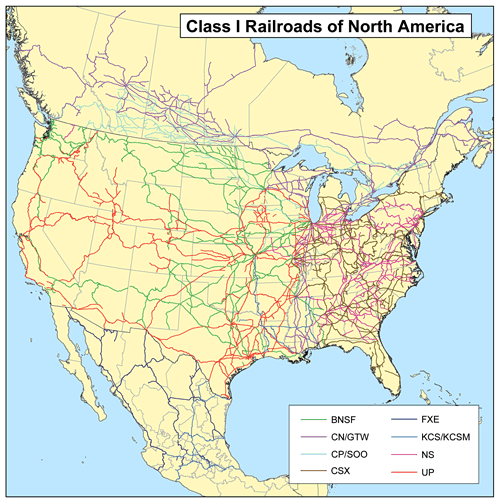
Railroad classes
Railroad classes are the system by which freight railroads are designated in the United States. Railroads are assigned to Class I, II or III according to annual revenue criteria originally set by the Surface Transportation Board in 1992. With annual adjustments for inflation, the 2019 thresholds were US$504,803,294 for Class I carriers and US$40,384,263 for Class II carriers. (Smaller carriers were Class III by default.)
Not to be confused with Track class.
There are six Class I freight railroad companies in the United States: BNSF Railway, CSX Transportation, Canadian National Railway, CPKC, Norfolk Southern Railway, and Union Pacific Railroad. Canadian National also operates in Canada and CPKC operates Canada and Mexico.
In addition, the national passenger railroad in the United States, Amtrak, would qualify as Class I if it were a freight carrier, as would Canada's Via Rail passenger service. Mexico's Ferromex freight railroad would also qualify as Class I, but it does not operate within the United States.
Initially (in 1911) the former federal agency Interstate Commerce Commission (ICC) classified railroads by their annual gross revenue. Class I railroads had an annual operating revenue of at least $1 million, while Class III railroad incomes were under $100,000. Railroads in both classes were subject to reporting requirements on a quarterly or annual schedule. In 1925, the ICC reported 174 Class I railroads, 282 Class II railroads, and 348 Class III railroads.[1]
The $1 million criterion established in 1911 for a Class I railroad was used until January 1, 1956, when the figure was increased to $3 million. In 1956, the ICC counted 113 Class I line-haul operating railroads (excluding "3 class I companies in systems") and 309 Class II railroads (excluding "3 class II companies in systems"). The Class III category was dropped in 1956 but reinstated in 1978. By 1963, the number of Class I railroads had dropped to 102; cutoffs were increased to $5 million by 1965,[2] to $10 million in 1976 and to $50 million in 1978, at which point only 41 railroads qualified as Class I.
In a special move in 1979, all switching and terminal railroads were re-designated Class III — even those with Class I or Class II revenues.
In early 1991, two Class II railroads, Montana Rail Link and Wisconsin Central, asked the ICC to increase the minimum annual operating revenue criteria (then established at US$93.5 million) to avoid being redesignated as Class I, which would have resulted in increased administrative and legal costs.[3] The Class II maximum criterion was increased in 1992 to $250 million annually, which resulted in the Florida East Coast Railway having its status changed to Class II.
The thresholds set in 1992 were:
Since dissolution of the ICC in 1996, the Surface Transportation Board (STB) has become responsible for defining criteria for each railroad class. The STB continues to use designations of Class II and Class III as there are different labor regulations for the two classes. The bounds are typically redefined every several years to adjust for inflation and other factors.
Class II and Class III designations are now rarely used outside the rail transport industry. The Association of American Railroads typically divides non–Class I companies into three categories: